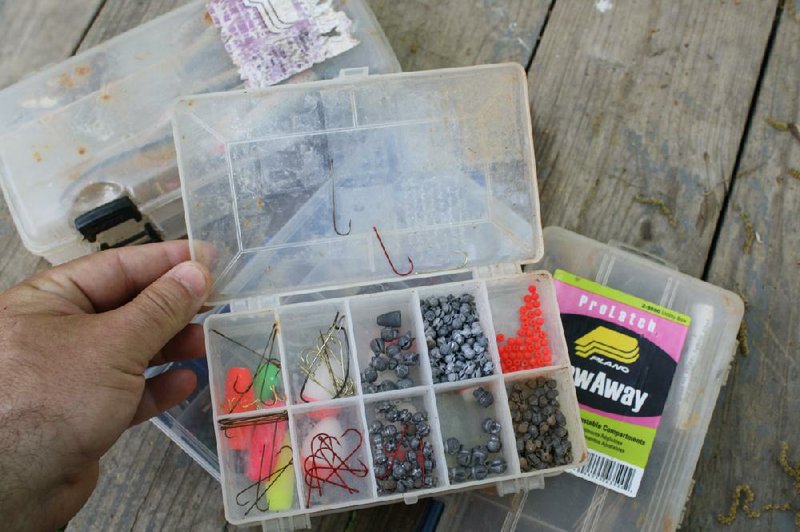You don't need a fishing license to fish through Sunday, so many Arkansans are fishing during the coronavirus pandemic, including beginners.
Newcomers face a veritable spreadsheet of mind-numbing choices, starting with equipment. You see all kinds of attractive lures at any big-box retailer, as well as specialty hooks and even specialty sinkers. These products are designed and marketed to advanced anglers, so newcomers might conclude they need to start at this level to catch fish. That means buying a lot of expensive gear that you don't know how to use.
That assumption is false.
Inexpensive entry-level equipment will accomplish three things:
It enables you to catch fish and enjoy fishing in the short term.
It enables you to grasp rudimentary skills during the steep upswing of the initial learning curve.
It allows you to sample fishing inexpensively while you decide whether you want to advance deeper into the sport.

For beginners, an inexpensive spincasting rig -- or closed face spinning reel -- is a serviceable starting point. The venerable Zebco 33 is the avatar of this genre, and it has been reeling in fish since its introduction in the 1950s.
While spincasters are widely regarded as introductory equipment, keep in mind that Woo Daves -- winner of the 2000 Bassmaster Classic -- relied on spincast reels in the early 1990s to flip jigs in extremely heavy cover where precise placement was key. Daves used the Zebco 808, and he won a major Bassmaster tournament with it. The fishing media regarded it as quaint and quirky nearly 30 years ago, but Daves proved that spincast equipment could fill a specialized niche at the elite fishing level.
The main advantage of spincast reels is that with very little practice, you can learn to cast them with pinpoint accuracy without the threat of backlash. An open face baitcasting reel is more accurate, but it takes considerably more practice to achieve accuracy and eliminate backlash.
Open-faced spinning reels are accurate, but you cannot overcome the lag between splashdown and locking the spool (closing the bail) that is inherent to spinning reels. In heavy cover, where strikes are often instant, that will cause you to lose fish. There is no avoiding it.
The main disadvantage to a spincast reel is its extremely slow retrieve speed. For that reason, spincasters are best suited for slow-retrieve lures and fishing with live bait.

For example, Bill Eldridge of Benton recently fished at Lake Ouachita with an older couple whose only equipment was Zebco spincasting outfits. They fished in the middle of a magic three-day period when the fishing was phenomenal. White bass and black bass schooled together in the evenings. Throwing a simple Tennessee shad colored, plastic paddletail minnow on a light ballhead jig, the couple caught big white bass as fast as they could cast for about two hours every evening. He also caught a big mess of largemouth bass in the 3-pound range and a good number of big Kentucky bass.
The couple is now replacing spincast equipment with more modern spinning equipment. For casual angling, the spincast gear was sufficient. A high-quality fishing experience revealed ample room for improvement.
The key factor is being present when fish are biting. The best equipment money can buy won't make fish bite during dead periods.
Spincast reels always come pre-spooled with line, so you don't have to worry about buying line. Usually, they also come as a package with a rod. It's always a cheap rod, but it works, so you don't have to worry about rods at the outset, either.

That leaves lures and baits as your only variable concern. Since spincast reels are almost always spooled with fairly heavy line, you need lures that are heavy enough to cast. Most 200 Series crankbaits are sufficient, as are lead jigs with soft plastic swimbaits and heavy inline spinnerbaits such as the Blue Fox Vibrax. These reels are also excellent for retrieving spinnerbaits slowly.
Any design jig will work, but ballheads are the cheapest and most common. For a spincast rig, 1/8-ounce is the lightest weight, and 1/4-ounce is probably the heaviest for swimming baits. For pitching jigs into flooded brush or lily pads, you can use as heavy of a weight as necessary for the application.
Fishing with live bait under a bobber is the ideal application for a spincast outfit, and it's also the ideal way for a beginner to learn how to fish.
If you fish from the bank, you're probably fishing for bluegills and, at this time of year, spawning crappie. This is the simplest kind of rod-and-reel fishing. You will need a long-shank, narrow gap bream hook. Attach a light split shot, 1/16-ounce, about 4 inches to 6 inches above the hook.
The bait should dangle just off the bottom, so affix your bobber at a place on the line that allows your bait to sink to that depth. A traditional red/white snap bobber is fine for short casts in shallow water, and its weight facilitates easy casting.
A pass-through balsa Thill bobber is more versatile. It requires affixing a bobber stopper to your line. It allows you to quickly adjust your bobber stop position to adjust to depth changes, or when you pinpoint the depth where fish are biting.
This is a live-bait game. Crickets and nightcrawlers work best. They are cheap. If you have the time, you can dig up or even grow your own nightcrawlers or redworms.
If you buy new equipment, your total investment for a weekend of fishing should easily be less than $100.
Sports on 03/26/2020

